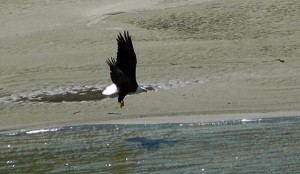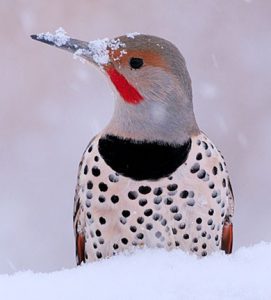Home »

Deep freeze makes for great birding
With some ‘degree’ of trepidation, naturalists checked the forecasted temperatures for January 4. Nevertheless, we set the alarm clocks.
Switching on the lights, and piling on the layers, we knew that the morning would be uncomfortable for ‘them’ and us. Assembling at the Platzl in Kimberley, 15 naturalists, from Cranbrook, Mayook, Fernie and Kimberley received our assignments and tackled the 117th Audubon Christmas Bird Count. Turns out, it was a great day for birding.
Four teams headed out into the four quadrants of the familiar ‘circle’, attempting to identify and record every bird. Yes, it was chilly, –32c, and birds were scarce at first. But soon we found some active, well-stocked feeders and the bright sun made it seem warmer.
 With its back to us, a Bald Eagle surveyed the frozen Kootenay River, woodpeckers pecked at suet and a striking Black-billed Magpie perched in the willows. Our lists grew.
With its back to us, a Bald Eagle surveyed the frozen Kootenay River, woodpeckers pecked at suet and a striking Black-billed Magpie perched in the willows. Our lists grew.
By midday, the temperature struggled up to the mild side of –20; the Rockies were outstanding. There was little or no wind and the traffic was quiet, so ‘birding by ear’ was productive. Occasionally, Red Crossbills chirped, woodpeckers drummed and Jays announced themselves.
Around 5 p.m., it was time to reconvene at the Marysville Hotel, to feed, re-hydrate and swap stories. All four teams acknowledged the privilege of contributing to some genuine citizen science.
A crested, greyish-blue bird, with bright blue wings and tail, barred and tipped with black and white, distinguishes the Blue Jay (pictured above). His noisy ‘jay-jay’ always proclaims his presence. Never remaining long in one place, he is on the leap constantly, with a dash and an impudent assurance that is amusing. When cold, as on ‘count day’, he was so fluffed that he appeared greyer than blue.
This increasingly common, large songbird, is known for its intelligence and complex social system with tight family bonds. The male is a devoted husband and father, who shows his best traits in his family circle. He reminds one of certain human beings who take excellent care of their own, but who are neither good neighbours nor desirable citizens.
The Blue Jay is a member of the same family to which the crow belongs, and while totally different in appearance, resembles him in his cleverness, his fearlessness and his audacious insolence. Cautious and silent in the vicinity of its nest, away from the nest he is bold and noisy.
In winter, Jays eat the eggs of the tent caterpillar, moth larvae, waste grains, nuts and seeds. In the east, their fondness for acorns is credited with helping spread oak trees following the last glacial period. Destroying grasshoppers late in the season, feeding on hibernating insects and their eggs, and eating beetles and weevils provide it’s best service to man. The wild fruits it selects are of no economic value.
The severest criticism against the species is the destruction of other birds and their eggs. Recently, however, extensive studies have shown that only one per cent of Jays had evidence of birds or eggs in their stomachs.
Blue Jays frequently mimic the calls of calls of hawks. These calls may provide information to other Jays that a hawk is around, or may be used to deceive other species into believing a hawk is present.
The Blue Jay is partially migratory, withdrawing several hundred kilometres from the extreme northern parts of it’s range. In recent years, these Jays have expanded their range into northeastern and southeastern parts of B.C. Bird feeders have probably encouraged expansion into western North America; this species is well adapted to human environments.
The Results
This was the 25th Kimberley Count. Forty-two species is around average.
It was a good year for the Bald Eagle, Eurasian Collared-Dove, Pileated Woodpecker and House Finch.
Common Goldeneye 19
Common Merganser 1
Ruffed Grouse 4
Golden Eagle 1
Northern Goshawk 1
Sharp-shinned/Cooper’s Hawk 1
Bald Eagle 14
Red-tailed Hawk 1
Rock Pigeon 28
Eurasian Collared-Dove 18
Northern Pygmy Owl 1
Downy Woodpecker 24
Hairy Woodpecker 18
Pileated Woodpecker 14

Northern Flicker 33
Northern Shrike 1
Steller’s Jay 8
Blue Jay 5
Black-billed Magpie 18
Clark’s Nutcracker 33
American Crow 57
Common Raven 67
Black-capped Chickadee 200
Mountain Chickadee 96
Red-breasted Nuthatch 28
White-breasted Nuthatch 4
American Dipper 5
Golden-crowned Kinglet 6
Townsend’s Solitaire 9
American Robin 5
Bohemian Waxwing 253

Snow Bunting 5
American Tree Sparrow 7
Dark-eyed Junco 24
Song Sparrow 6
Red-winged Blackbird 8
House Finch 195
Red Crossbill 10
Pine Siskin 12
Common Redpoll 10
American Goldfinch 26
Evening Grosbeak 15
Thanks to roving counters and feeder watchers.
See Cranbrook Christmas Bird Count results
See Fernie Christmas Bird Count results
Lead image: Blue Jay by Lyle Grisedale
– Submitted by Daryl Calder on behalf of Rocky Mountain Naturalists








